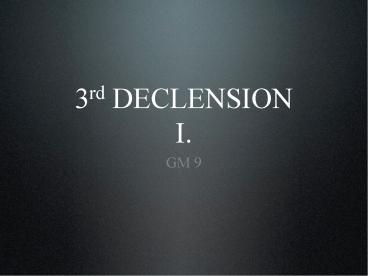3rd DECLENSION I. PowerPoint PPT Presentation
Title: 3rd DECLENSION I.
1
3rd DECLENSION I.
- GM 9
2
Content
- Introductory information.
- Division of the 3rd declension.
- Paradigm.
- Examples of use.
- Textbook.
3
Introductory information
- All words belonging to the 3rd declension have
Gen. Sg. with ending -is. There is no exception
from this rule. - 3rd declension is the biggest one among groups of
Latin nouns. Also it is the most complicated.
Therefore we will divide the subject to two
parts. - Internally the declension is split up to two
groups called parisyllabics and imparisyllabics.
4
Parisyllabics and imparisyllabics
- Terms parisyllabic/imparisyllabic mean in LMT
words with same or different number of
syllables in Nom. and Gen. Sg.. Demonstration - auris (Nom. Sg.) has Gen. Sg. auris and is
therefore parisyllabic (two and two syllables). - foramen (3 syllables), Gen. Sg. foraminis (4
syllables) is imparisyllabic.
5
Introductory information 2
- For sake of simplicity we can consider
imparisyllabics to be a basic form. Parisyllabics
will be derived later from this former version in
the next lesson. - Imparisyllabics contain two paradigms
- dolor used for masculines and feminines
- caput used for neuters.
6
- The most prominent feature of this declension is
variety of endings in Nom. Sg. So far declensions
have had only limited amount of versions usually
associated with certain gender. (Example -us/-er
for masculines in the 2nd declension, -a for
feminines in the 1st decl., etc.) - The list of possible endings in the nominative
singular of the 3rd declension would contain more
than 20 different entries! Example calor, apex,
operatio, mater, foramen, coma, etc.
7
- There are three consequences
- Relation between the nominative ending and gender
of given noun, which used to be relatively
straightforward (musculus is M, vena is F,
intestinum N), is in the 3rd decl. very
complicated. Therefore you must remember exactly
a gender of every word belonging to this
declension. - Nominative endings are nevertheless used to
distinguish between particular subgroups of the
3rd declension (paradigms). This will be
explained in the future lessons. - Difference between Nom. Sg. and Gen. Sg. often
includes also an alteration of stem.
8
Paradigm dolor, is
(is used for masculines and feminines)
Sg. Pl.
Nom. dolor dolor -es
Gen. dolor -is dolor -um
Acc. dolor -em dolor -es
Abl. dolor -e dolor -ibus
Due the complicated nature of the 3rd
declension, the Nom. Sg. ending can be any of
more than 20 variations.
9
Paradigm caput, itis
(is used for neutrals)
Sg. Pl.
Nom. caput capit -a
Gen. capit -is capit -um
Acc. caput capit -a
Abl. capit -e capit -ibus
In neutral paradigms the accusative grammatical
case is always same as nominative.
10
Stem alterations
- Word caput, capitis is not only a paradigm for
neutrals, but it is also example of stem
alteration. - Normally a Latin noun changes in various cases
only its ending. However certain nouns in the 3rd
declension alternate also stems. - If there is a different stem it is always
indicated in the vocabulary form of the word.
Exampleapex, icis m. here ic in the genitive
ending signifies that although nominative is
apex, the genitive will be apicis.
11
Change in stem
haluc- pulver- operation- foramin-
-em -es -is -a
stems
endings
A word with no change in stem has in vocabulary
form only -is ending. If there is an alteration,
then it is indicated in genitive ending. Compare
following vocabulary forms
calor, is m. sudor, is m. ren, is m.
index, dicis m. suspicio, onis, f. coma, comatis
n.
change
no change
12
Comments
- On the page 108 in the textbook there are three
different paradigms for the 3rd declension apart
from dolor and caput there is also operatio. - But if you compare dolor (masculine) and operatio
(feminine) you will see that they are the same. - Therefore we will use only dolor for both
masculines and feminines.
13
Comments
- Word latus (p. 111) is tricky. We have an
adjective latus, lata, latum (meaning wide) and
a noun latus, lateris n. (meaning side). - There are two words with the same nominative os.
The first is os, oris n. (mouth) and the second
is os, ossis n. (bone). - Further, the bone has an exception in Gen. Pl.
ending. Instead of -um we must use -ium (os,
ossis, ossium NOT ossum).
14
Textbook
- Explanation of the 3rd declension p. 106 - 108.
- Vocabulary 108 - 112.

